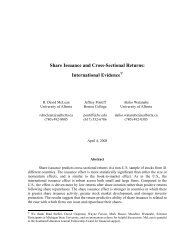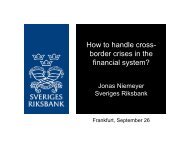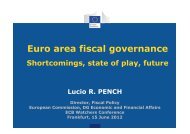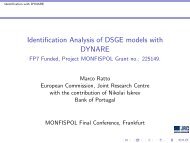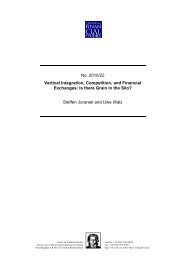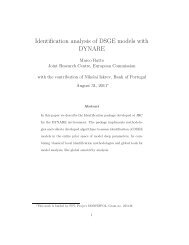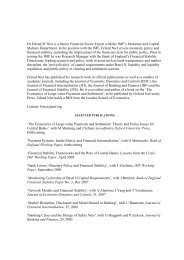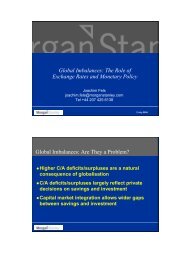Forecasting and Policy Making (Paper) - Center for Financial Studies
Forecasting and Policy Making (Paper) - Center for Financial Studies
Forecasting and Policy Making (Paper) - Center for Financial Studies
Create successful ePaper yourself
Turn your PDF publications into a flip-book with our unique Google optimized e-Paper software.
slightly below the <strong>for</strong>ecasts from the non-structural models.<br />
Figure 8 displays projections <strong>for</strong> quarter-to-quarter CPI inflation <strong>and</strong> <strong>for</strong> the federal funds<br />
rate. The model correctly predicts inflation to fall during the recession, but it fails to capture the<br />
5<br />
0<br />
−5<br />
−10<br />
Quarterly annualized inflation rate<br />
2007 2008 2009 2010 2011<br />
6<br />
4<br />
2<br />
0<br />
−2<br />
Nominal short term interest rate<br />
2007 2008 2009 2010 2011<br />
Figure 8: Data (black line) <strong>and</strong> <strong>for</strong>ecasts (blue lines) of annualized quarter-on-quarter inflation <strong>and</strong> the federal funds rate.<br />
extreme decline in the fourth quarter of 2008. ¿From 2009 onwards inflation projections are fairly<br />
precise. The projections of the federal funds rate explain why output growth estimates during the<br />
recovery turn out too optimistic. The model <strong>for</strong>ecast does not en<strong>for</strong>ce the zero bound on nominal<br />
interest rates. It allows rates to turn negative thereby incorporating too much stimulus to output.<br />
Imposing the zero-interest-floor on nominal interest rates would have resulted in less optimistic<br />
output <strong>for</strong>ecasts. We will demonstrate a simple procedure <strong>for</strong> adjusting <strong>for</strong>ecasts to take into account<br />
the zero-lower-bound in section 5.6.<br />
Structural shocks <strong>and</strong> <strong>for</strong>ecast interpretation<br />
Another unobservable element of structural models are the economic shocks. Structural shocks<br />
differ from estimation residuals. They require identification via parametric restrictions <strong>and</strong> in models<br />
with <strong>for</strong>ward-looking terms the computation of the rational expectation of future variables so as to<br />
determine the <strong>for</strong>ecast error. As a result of the identification the shock can possibly be interpreted<br />
as a meaningful economic disturbance. Of course, the extent of useful interpretation depends on the<br />
economic foundations <strong>for</strong> the parametric restrictions in the model. Since the IMF projection model<br />
is not strictly micro-founded in all respects, some of these shocks have little concrete interpretation<br />
such as the shocks to potential output growth. But other shocks offer useful insights. For example,<br />
distinguishing aggregate dem<strong>and</strong> shocks in the IS curve, from cost-push shocks in the Phillips curve<br />
<strong>and</strong> long-run supply shocks to potential output, helps underst<strong>and</strong>ing whether inflation is primarily<br />
driven by dem<strong>and</strong>-pull factors, short-run cost-push shocks or productivity changes that may be related<br />
to technological improvements.<br />
Figure 9 display the estimated series of structural shocks. The sequence of negative dem<strong>and</strong><br />
shocks between 2008 <strong>and</strong> 2010 indicates that according to this model an unexpected shortfall of de-<br />
m<strong>and</strong> (i.e. the shocks) caused an unexpected decline in GDP. Furthermore, the sequence of positive<br />
monetary policy shocks in 2009 indicates that interest rates where higher than expected based on<br />
the policy rule, <strong>and</strong> there<strong>for</strong>e represented an additional cause <strong>for</strong> an unexpected decline in GDP. The<br />
44



